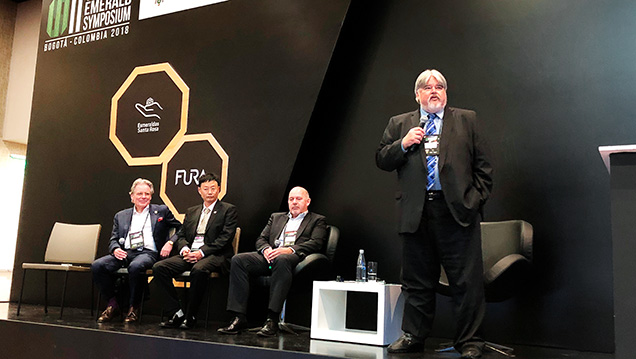Second World Emerald Symposium

Hosted by Fedesmeraldas (the Colombian Emerald Federation), Acodes (the Emerald Exporter Association), Aprecol (the Emerald Producers Association), Asocoemeral (the Emerald Dealers Association), and Minminas (the Ministry of Mines), the second World Emerald Symposium was held in Bogotá October 12–14, 2018.
The inaugural event in 2015 was themed “Be part of the change.” Three years later, the emphasis was on sustainability, blockchain, nanotechnology, and traceability. Does the community share the benefit from the companies? The future of the emerald industry should develop with the local communities through education, improving health care and working conditions. These questions/keywords were among the important topics expressed during this second edition of the symposium.
More than 60 Colombian and international speakers and panelists presented a wide variety of topics such as gemology, ethics, government, stakeholders, and marketing before a large audience from around the world and representing all levels in the emerald industry.
Day one began with opening talks by Colombian officials, symposium organizers, and presidents of gem and jewelry associations (ICA, CIBJO, and AGTA). This was followed by geology and mining sessions. Gaston Giuliani (IRD, CRPG, Nancy, France) again offered an exciting talk on world emerald deposits in the 21st century, assessing current knowledge, types of deposit, and exploration. Lee Groat (University of British Columbia, Vancouver) spoke on emerald occurrences in Canada’s Yukon Territory and the challenges for exploration and exploitation. Gian Carlo Parodi (National Museum of Natural History, Paris) reviewed the species and varieties of the beryl group and shared photos of various rare collector specimens such as stoppaniite and bazzite.
In the afternoon session on gemology, Gabriel Angarita (CDTEC Gemlab, Bogotá) introduced a new treatment for emeralds coming onto the market called “Naturalys.” He compared it to traditional oil treatment or resin and described its identification. Taijin Lu (NGTC, Beijing) discussed the recently formed Chinese national standard on emerald grading. Vincent Pardieu (DANAT, Bahrain) spoke on emerald from Madagascar and presented a well-made video from his most recent field expedition to Madagascar. Olivier Segura (L'École des Arts Joailliers, Paris) presented the school, which is supported by Van Cleef & Arpels, and its rich variety of classes such as jewelry history, gouache techniques, setting, gemology, and more.
Andy Lucas (Guild Gemlab, Shenzhen) talked about educating Chinese consumers on colored gemstones and China’s potential as a luxury jewelry market. He concluded by introducing the new education programs offered by the Guild Institute of Gemology. Alan Hart (Gem-A, London) reviewed the association’s heritage and long history. He also presented Gem-A resources such as its library, the Journal of Gemmology, and traditional education and alumni activities across the world.
This first day ended with two panel discussions, with Ronald Ringsrud and Shane McClure moderating the first. Laurent Cartier (SSEF, Basel), Gagan Choudhary (GTL, Jaipur), Rodrigo Giraldo (RGLAB, Bogotá), and Aurélien Delaunay (LFG, Paris) discussed laboratory reports on emerald treatments and the difficulties in determining the degree of enhancement. Is it a subjective call? Is a finding of minor, moderate, or significant enhancement sufficient, or would the addition of more degrees of enhancement on the reports be more accurate and benefit the industry? These were among the questions exchanged.
A second panel on gemology and origin (figure 1) was led by Shane McClure with panelists Kenneth Scarratt (DANAT), Taijin Lu (NGTC), and Claudio Milisenda (DSEF German Gem Lab). The group offered a frank discussion of many critical issues on country of origin determination. They also shared the difficulties gem labs encounter in building a reliable dataset to support country of origin determination. Potential solutions were also proposed.
The second day emphasized stakeholders’ social responsibility, ethics, and marketing. The day began with speakers from mining companies. Assheton Carter (The Dragonfly Initiative), Rosie Perkins (FURA Gems), German Forero (Santa Rosa), and Elena Basaglia (Gemfields) talked about their respective projects on sustainability and development of social programs to support local communities. Projects included modernizing the mines, developing schools, and implementing health care systems. Independent consultant Gerardo Vargas concluded the session by discussing the importance of appellation of origin for Colombian emeralds and how it would benefit and protect the market, increase value, develop the industry, and give recognition to Colombian emeralds.
After the lunch break, the session continued with Prida Tiasuwan (Pranda Group) who offered insight on Thailand’s gem and jewelry industry and its potential as a global gem and jewelry hub. Pointing at the duty-free, tax-free, and non-VAT trading system for gemstones, he talked about Thailand as a major center for colored stone education, cutting, manufacturing, and treatment.
Zhao Xin Hua presented information on the Gemstone Association of China and shared data and statistics on the Chinese colored gem market. Liu Yi (GAGCC) talked about the gem and jewelry investment hub opportunities with China. Next, Laurent Cartier (Gemstones and Sustainable Development Knowledge Hub) explained the organization’s work and discussed the challenges regarding artisanal mining, short-life deposits, stock management, and consideration of quality over origin.
The last session was devoted to ethics and corporate social responsibility. Cathlijne Klomp (LVMH) spoke about responsible sourcing of colored gemstones as well as the challenges and opportunities for creating sustainable value. Next, Charles Chaussepied (Responsible Jewellery Council) explained the RJC’s history, role, and mission. This last session was by a panel discussion regarding certifications with Edwin Molina (APRECOL) and Charles Burgess (Muzo MTC).
Day three was a half-day exploration of history. Independent jewelry specialist Joanna Hardy spoke on the Colombian emerald pocket watch from the Cheapside Hoard, the emerald and diamond parure of Empress Marie-Louise of France, and many other important antique emerald jewels. Ronald Ringsrud followed with more storytelling about people, miners, and emerald adventures. Ioannis Alexandris (Gemolithos) covered the magnificent Old Mine emeralds, historical jewelry featuring Colombian emeralds, and record-breaking auction sales. Gerard Martayan (Schlumberger) reviewed the rediscovery of the fascinating Chivor emerald mine.
Closing keynote addresses by Shri Pramon Agrawal (GJEPC), Carlos Amaya (governor of Boyacá), and Oscar Baquero (Fedesmeraldas) concluded the 2nd World Emerald Symposium



